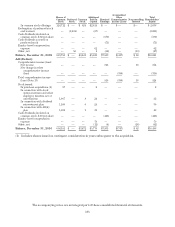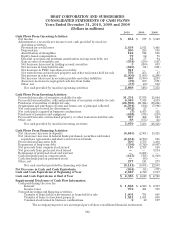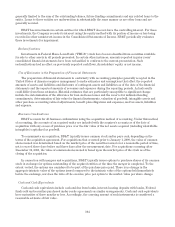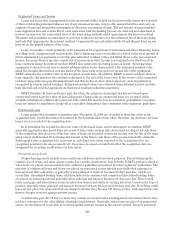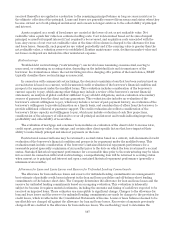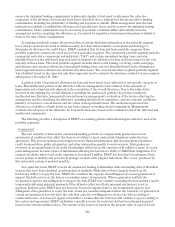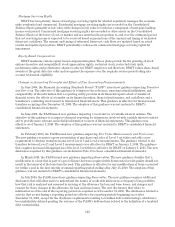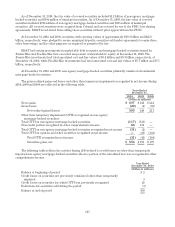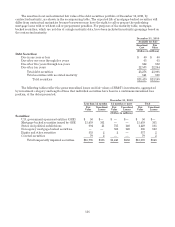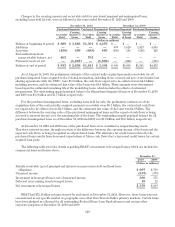BB&T 2010 Annual Report Download - page 110
Download and view the complete annual report
Please find page 110 of the 2010 BB&T annual report below. You can navigate through the pages in the report by either clicking on the pages listed below, or by using the keyword search tool below to find specific information within the annual report.Securities Sold Under Repurchase Agreements
Securities sold under repurchase agreements generally have maturities ranging from 1 day to 36 months.
Securities sold under agreements to repurchase are reflected as collateralized borrowings on the Consolidated
Balance Sheets and are record based on the amount of cash received in connection with the borrowing. The terms
of repurchase agreements may require BB&T to provide additional collateral if the fair value of the securities
underlying the borrowings declines during the term of the agreement.
Income Taxes
Deferred income taxes have been provided when different accounting methods have been used in
determining income for income tax purposes and for financial reporting purposes. Deferred tax assets and
liabilities are recognized based on future tax consequences attributable to differences arising from the financial
statement carrying values of assets and liabilities and their tax bases. In the event of changes in the tax laws,
deferred tax assets and liabilities are adjusted in the period of the enactment of those changes, with the
cumulative effects included in the current year’s income tax provision.
Derivative Financial Instruments
A derivative is a financial instrument that derives its cash flows, and therefore its value, by reference to an
underlying instrument, index or referenced interest rate. These instruments include interest rate swaps, caps,
floors, collars, financial forwards and futures contracts, swaptions, when-issued securities, foreign exchange
contracts and options written and purchased. BB&T uses derivatives primarily to manage economic risk related
to securities, commercial loans, mortgage servicing rights and mortgage banking operations, Federal funds
purchased, other time deposits, long-term debt and institutional certificates of deposit. BB&T also uses
derivatives to facilitate transactions on behalf of its clients. The fair value of derivatives in a gain or loss position
is included in other assets or liabilities, respectively, on the Consolidated Balance Sheets.
BB&T classifies its derivative financial instruments as either (1) a hedge of an exposure to changes in the fair
value of a recorded asset or liability (“fair value hedge”), (2) a hedge of an exposure to changes in the cash flows of
a recognized asset, liability or forecasted transaction (“cash flow hedge”), (3) a hedge of a net investment in a
subsidiary, or (4) derivatives not designated as hedges. Changes in the fair value of derivatives not designated as
hedges are recognized in current period earnings. BB&T has master netting agreements with the derivatives
dealers with which it does business, but reflects gross gains and losses on the Consolidated Balance Sheets.
BB&T uses the long-haul method to assess hedge effectiveness. BB&T documents, both at inception and over the
life of the hedge, at least quarterly, its analysis of actual and expected hedge effectiveness. This analysis includes
techniques such as regression analysis and hypothetical derivatives to demonstrate that the hedge has been, and is
expected to be, highly effective in off-setting corresponding changes in the fair value or cash flows of the hedged item.
For cash flow hedges involving interest rate caps and collars, this analysis also includes consideration whether critical
terms match, the strike price of the hedging option matches the specified level beyond (or within) which the entity’s
exposure is being hedged, the hedging instrument’s inflows (outflows) at its maturity date completely offset the change
in the hedged transaction’s cash flows for the risk being hedged and the hedging instrument can be exercised only on
its contractual maturity date. For a qualifying fair value hedge, changes in the value of the derivatives that have been
highly effective as hedges are recognized in current period earnings along with the corresponding changes in the fair
value of the designated hedged item attributable to the risk being hedged. For a qualifying cash flow hedge, the
portion of changes in the fair value of the derivatives that have been highly effective are recognized in other
comprehensive income until the related cash flows from the hedged item are recognized in earnings. For qualifying
cash flow hedges involving interest rate caps and collars, the initial fair value of the premium paid is allocated and
recognized in the same future period that the hedged forecasted transaction impacts earnings.
For either fair value hedges or cash flow hedges, ineffectiveness may be recognized in noninterest income to
the extent that changes in the value of the derivative instruments do not perfectly offset changes in the value of
the hedged items. If the hedge ceases to be highly effective, BB&T discontinues hedge accounting and recognizes
the changes in fair value in current period earnings. If a derivative that qualifies as a fair value or cash flow hedge
is terminated or the designation removed, the realized or then unrealized gain or loss is recognized into income
over the original hedge period (fair value hedge) or period in which the hedged item affects earnings (cash flow
hedge). Immediate recognition in earnings is required upon sale or extinguishment of the hedged item (fair value
hedge) or if it is probable that the hedged cash flows will not occur (cash flow hedge).
110



